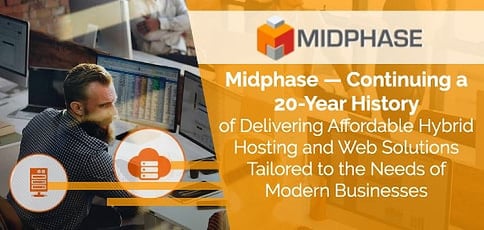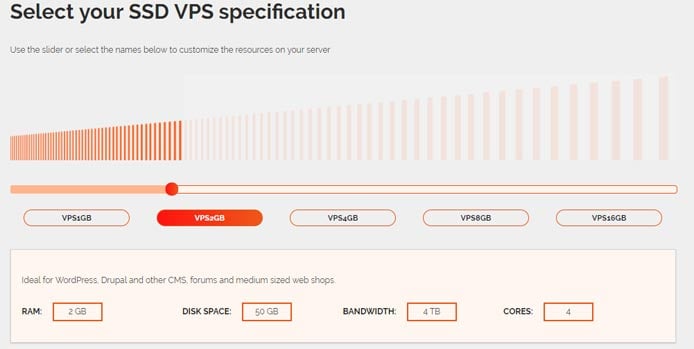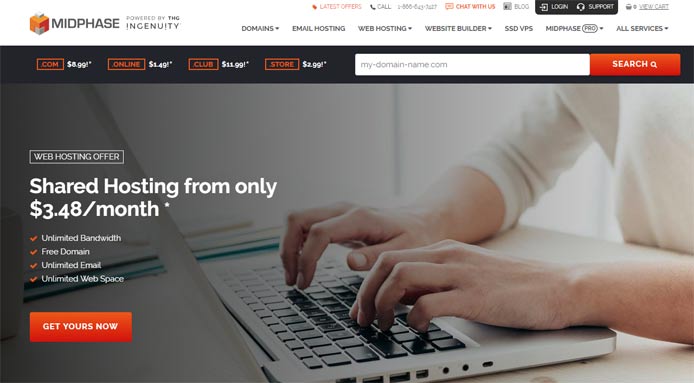
TL; DR: Midphase, a hybrid hosting provider known for its affordable price points, started from humble beginnings and has seen its business steadily rise over the past two decades. Initially part of the UK2 Group of technical brands acquired by Lloyds Development Capital and now powered by The Hut Group and THG Ingenuity, Midphase and its partners are gaining a growing share of the market. We recently sat down with Greg Rodriguez, SVP at The Hut Group, who told us how the organization’s customized hosting solutions, passionate customer support team, and focused segmentation approach help the company stay well ahead of the competition.
Acquisition in the hosting industry is nothing new, with groups joining forces on a regular basis to reshape the hosting landscape — often enhancing company performance and creating operational advantages in the process. And it just so happens that the story behind Providence, Utah-based Midphase illustrates this trend perfectly.
Midphase first entered the domain registration and hosting market in 1998 to help people and businesses successfully connect online. Coincidentally, UK2.net was formed across the Pacific Ocean the same year as a low-cost domain name provider. By 2000, UK2.net had cornered a large slice of the UK hosting market, serving approximately 435,000 customers.
Looking to expand its market share, UK2.net began exploring acquisition options and eventually identified Midphase as its US counterpart. In 2007, UK2.net purchased Midphase and a number of other brands — including 100TB, Wesell.biz, WestHost, and VPS.net — under the UK2 Group umbrella. Just three years later, private equity company Lloyds Development Capital (LDC) acquired UK2 Group for about $77 million as part of a management buyout.

THG’s Greg Rodriguez told us acquiring Midphase was an integral part of the company’s strategic growth plan.
In just over 10 years, the organization had experienced a swift growth spurt — but it was not nearly over.
“In May 2017, The Hut Group, the largest privately-held company in England, acquired from LDC the UK2 Group, which came with all of those different brands,” Greg Rodriguez, SVP in the THG Ingenuity team, said. “The Hut Group is now launching its technical brand called THG Ingenuity, and we’re going to take that to the next level and roll all these different brands under our value proposition — under the THG Ingenuity umbrella — and take that to market.”
À la Carte Hosting Solutions Tailored to Individual Need
From domain products and site builders to web hosting and SSD VPS packages, Midphase’s offerings run the gamut. But the diverse portfolio isn’t overwhelming because Midphase guides customers through each step of the process.
“Midphase, specifically, has very economical price points and is extremely competitive,” Greg said. “It’s a diverse portfolio that really lets us guide you and lets the customer be in control of a hybrid solution, an à la carte solution that meets their needs versus us putting together a package saying ‘You need a shoe on your business — is it one of these good, better, best options?’”

Midphase customers can choose from an array of hosting options that fit their specific business missions and budgets.
Still, Midphase is just a piece of the puzzle. Since Midphase is one of the many brands under THG Ingenuity’s diverse portfolio, Midphase customers can straddle a variety of different platforms — whether it’s shared, bare metal, virtual, or cloud servers.
“Users can leverage the powerhouse of The Hut Group internationally,” Greg said. “Then, we will bring that into the US market, so it’s a global powerhouse from a new perspective.”
A Focused Approach to the Domain, Website, and Hosting Market
Now under the THG Ingenuity umbrella, Midphase has worked hard to define an appropriate market niche.
“Take the left to right analogy — or let’s call it a self-service, small ARPU all the way up to a high-service, high ARPU example,” Greg said. “On the left side, you’ve got the public cloud, on the far left commoditized technology with self-service driven through AWS, Azure, and GCP, with low price points as it scales. And then on the far right, you’ve got managed hosting providers with high levels of managed support, proactive support, and high ARPUs.”
As a whole, Greg noted that THG Ingenuity has made a concerted effort not to compete in those areas for a variety of reasons.

Whether you’re seeking shared hosting, virtual private servers, or site-building solutions, Midphase has you covered.
“It’s a race to the bottom on price in the public cloud sector, and it’d be really difficult to topple the giants that are there,” he said. “It’s just a very expensive proposition on the far right to provide heavy managed services, heavy practice support, whether you call it Fanatical Support, like Rackspace does, or a Gargantuan Support or Heroic Support. We didn’t want to get into that game either because of the costs you have to throw at it, and then you could potentially see diminishing returns. So we feel pretty good about the swim lanes that we’re playing in.”
To make sure they stay in those lanes, the company builds up strategic value propositions for their brands while avoiding direct competition with giants.
“We’re very strategic in making sure that, on the bare-metal side, we aren’t going head-to-head with the managed hosting providers of today — with Rackspace being the leader in that industry — and then on the far left, making sure we aren’t going head-to-head from a product or value prop perspective against public cloud leaders such as AWS, Azure, and GCP,” Greg said.
Greg told us the goal is to carve out a niche for Midphase’s value proposition in the market.
That’s how you’re seeing the business really evolve,” he said.
One Step Ahead: Remaining Competitive Amid Changing Trends
Greg, who has been involved in the market for 18 years, compares the rise and fall of industry trends to a rollercoaster.
“Before virtualization, before ‘cloud’ was a buzzword, colocation was really big,” he said. “And then over the years the colocation market dwindled a bit, and you saw, with the likes of Rackspace and then others, especially with AWS coming in, the public cloud market being defined.”
This world of virtualization ultimately led to the term “cloud” being coined, and companies were seeing customers actively seek out cloud solutions. At that point, Greg recalls a tremendous shift of customers moving from bare metal to the public cloud.
“This was before the advent of private cloud or OpenStack,” he said. “And they really over-course-corrected and shifted all their workloads and use cases to the public cloud, not realizing what the tradeoffs were.”
After customers became more informed about security and redundancy challenges inherent in the public cloud, the tides shifted again.
“You started seeing a course correction back with the emergence of private clouds to mitigate those risks,” Greg said. “I think the trend that you’re seeing now is a resurgence in bare metal, so that roller coaster was kind of coming full circle.”
Greg said that revival is partially due to declining prices.
“The cost of the gear has come down significantly over the years, and the different pieces of software and technologies that you can run on top of bare metal have expanded significantly,” he said. “You’re really seeing this hybrid model continue to perpetuate, and you no longer have to make the decision to pick one or the other. The hybrid solution is really becoming the de facto for 70 to 80% of customers, where they’ll run a specific amount in the public cloud, some in the private cloud, and then bare metal is again starting to make that resurgence.”
A Passionate Support Team with Flexible Service Options
From a service perspective, Greg said Midphase’s responsibility is to direct customers to the solutions that best suit them and adjust their level of involvement according to customer need. Happily, the many brands that now reside within THG Ingenuity share a similar value proposition in this respect.
“When LDC was diversifying its portfolio, prior to the acquisition from THG, Midphase was an acquisition they picked up that really resonated and complemented the UK2.net portfolio, but in the states,” Greg said.
The same was true for WestHost, which also shared a similar company culture.
“It’s a great suite of offerings, and we have amazing support on hand, if and when you need us,” Greg said. “When you do need us, we’re extremely proactive, and when you don’t, we’re not hounding you, calling you every day and letting you know that you need to add more ram and disk space and an extra hard drive. We really pivot and adjust to the support needs that our customers are asking for.”
HostingAdvice.com is a free online resource that offers valuable content and comparison services to users. To keep this resource 100% free, we receive compensation from many of the offers listed on the site. Along with key review factors, this compensation may impact how and where products appear across the site (including, for example, the order in which they appear). HostingAdvice.com does not include the entire universe of available offers. Editorial opinions expressed on the site are strictly our own and are not provided, endorsed, or approved by advertisers.
Our site is committed to publishing independent, accurate content guided by strict editorial guidelines. Before articles and reviews are published on our site, they undergo a thorough review process performed by a team of independent editors and subject-matter experts to ensure the content’s accuracy, timeliness, and impartiality. Our editorial team is separate and independent of our site’s advertisers, and the opinions they express on our site are their own. To read more about our team members and their editorial backgrounds, please visit our site’s About page.

